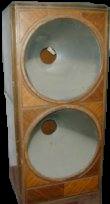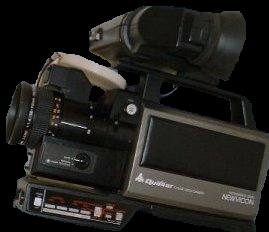Topics
- Analog Video
- Digital Video
- Infrared Video
- Thermal Video
- Film Camera
- Digital Camera
- Audio Recorders
- EMF Detectors
- Motion Detectors
- Robotics
- Digital Debate


Analog Video
 |
Video cameras have been around since the inception of television back in the 30s. The first studio cameras were black and white, very heavy and of the mechanical nature. Portability was impossible and the price tags were outrageous! (Though it may look like the first bass box for the model T, its actually one of the first RCA mechanical video cameras boasting an awsome 120 lines of resolution). Home video recording equipment would not be available until the late 60s and didn't became popular until the late 70s. The picture quality was fare but the price was that of a new car. Many innovations and changes have come since those first video cameras hit the market. Digital recording, Night-vision, 700X zoom, digital image stabilization and many other features have only been added in the last few years. |
The first home video cameras were large, heavy and bulky. Most were black and white and required a seperate video deck for recording. These cameras were based on their studio counterparts using image disector tubes to capture images. These cameras created exellent pictures in bright light, but use in a lower light setting was almost impossible. |  |
 |
Image disector tubes like the one to the left made video capture possible. This works almost like the reverse of a television using an electron gun inside the tube. The image in front of the camera is reflected onto a plate through the lens, the electron gun scans the image on the plate. An elctro magnet (not shown) which surrounds the tube is used to control the scanning of the electron beam. Once the image is scanned it is turned into an analog signal and then sent to the video recorder. |
In the late 70s and early 80s CCDs emerged on to the market. Most cameras after this time used CCD technology, it is much smaller, requires less energy to operate and creates a much higher and sharper resolution picture. These CCD sensors are the same sensors found in VHS, VHS-C, 8mm and digital camcorder, digital still cameras, web cams and other imaging devices. Though the CCD works the same for all of these devices the resulting signal for these older devices was analog . CCD technology allowed the video recorder to be integrated with the camera to create the camcorders we use today. |  |
Unfortunately, the older tube cameras were not very efficent in lower light settings and the resulting picutre was just a black screen. Tube cameras can see into the infrared spectrum to some degree, but its sensativity is not of a CCD. Though these problems effect the overal viewable picture quality, these cameras still have their place in ghost hunting. Because they use electron beams and are very prone to electrical and magnetic distrubances, these cameras will most likely be effected by spirit energy and electromagentic disturbances. These disturbances can easily be recorded from the camera.
